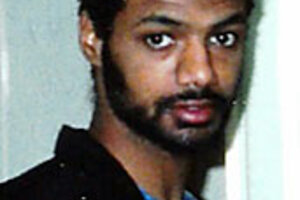In Guantánamo case, a judge tightens the screws on the US
He is insisting that the government disclose any evidence that points to a detainee's innocence in a 'dirty bomb' plot.

Binyam Mohamed: The US said in October that it won't use a 'dirty bomb' plot as evidence against him.
PA WIRE/AP/File
Washington
A major battle is brewing in federal court here over the well-established legal requirement that the government must turn over any exculpatory evidence it has uncovered to an accused criminal it is seeking to imprison.
But what if that person is a suspected terrorist being held as an enemy combatant at Guantánamo Bay, Cuba?
That's the issue before US District Judge Emmet Sullivan, who is presiding over a high-stakes legal dispute involving allegations that US intelligence agents secretly sent a man to Morocco for 18 months of torture before transferring him to prisons in Afghanistan and then Guantánamo.
Judge Sullivan has ordered the government to turn over exculpatory evidence about the man, but Justice Department lawyers are seeking to narrow the judge's order.
The issue arises in the case of Binyam Mohamed, an Ethiopian-born former British resident accused of plotting with American citizen Jose Padilla to detonate a radiological "dirty bomb" in the US. Mr. Mohamed has been held at Guantánamo for four years and has filed a habeas corpus petition challenging the legality of his continued military detention.
He is being held as an enemy combatant on the basis of what government lawyers say are his admissions to interrogators that he attended Al Qaeda training camps in Afghanistan and was involved in a dirty-bomb plot.
Mohamed's lawyers say many of the alleged admissions were coerced and are false. They argue in their habeas petition that because the government is relying on alleged confessions by their client, they must be afforded an opportunity to examine the conditions and circumstances that led to Mohamed's statements.
They present a Manchurian candidate argument, that Mohamed was tortured for two years – from May 2002 to May 2004 – to condition him to later confess to his involvement in terrorism. He was subjected to repetitive abuse until he replied to the interrogators' questions with the answers US officials desired, Mohamed's lawyers charge.
The US government, they add, wanted to use Mohamed as a witness against top Al Qaeda leader Khaled Shaikh Mohammed, the alleged 9/11 mastermind. In reality, the lawyers say, Mohamed was a "nobody" who was swept up and then chewed up in America's post-9/11 dragnet.
US behavior is backdrop
Mohamed's case is closely watched because it involves allegations of US-sanctioned torture and the potential use of coerced statements as evidence against longtime Guantánamo detainees. It is one of more than 200 habeas challenges now pending in federal court in Washington on behalf of detainees at the Guantánamo terrorism prison camp. His case has already triggered an investigation by British authorities into possible wrongdoing by that nation's intelligence agents, who allegedly cooperated with US authorities in the Mohamed affair.
In the US, the Mohamed case marks a test of the Supreme Court's decision in June granting detainees a constitutional right to challenge the legality of their detentions in federal court. It is also a test of a similar decision favoring detainees handed down by the US Court of Appeals for the District of Columbia.
After Sullivan ordered the government to turn over favorable evidence to Mohamed's lawyers, Justice Department lawyers announced in October that they would no longer seek to use the dirty-bomb plot as evidence against Mohamed. Nonetheless, the judge ordered government lawyers to disclose to Mohamed's lawyers any dirty-bomb evidence suggesting that Mohamed was innocent of involvement.
Mohamed's lawyers say in court filings that there never was a dirty-bomb plot. The allegation stems from a joke website, they say.
Justice Department lawyers say they stand by the original allegation. But they also insist that all they must prove to defeat the habeas petition is that Mohamed attended a training camp in Afghanistan. The conditions and circumstances of Mohamed's earlier treatment and interrogations are not relevant to his status as an enemy combatant, they say.
Judge's gauge of the evidence
In a status conference on Monday, Cori Crider, one of Mohamed's lawyers, said the Justice Department had turned over some exculpatory evidence but was still withholding evidence. "They have a great deal of information that will demonstrate his statements weren't voluntary, that they were the product of torture," she said.
Ms. Crider said the government had not acknowledged Mohamed's whereabouts from 2002 to 2004. "There is a huge black hole in the case," she said.
Justice Department lawyer Andrew Warden told the judge that "several hundred pages" of evidence had been turned over. The extent of the government's disclosure is unclear because most of the information is classified. The judge must be "prudent and incremental" in his approach to the disclosure issue, Mr. Warden said.
But the judge countered that he must determine the reliability of Mohamed's statements if they are to be used as evidence against him. To do so, the judge suggested, he may need to examine "what were the conditions. How were the [interrogation] sessions conducted."
Sullivan set a deadline. He gave the government until Dec. 11 to obtain an affidavit that must be sworn under penalty of perjury from Secretary of Defense Robert Gates, verifying that all exculpatory evidence has been turned over to Mohamed's lawyers. He says his order includes exculpatory evidence related to the alleged dirty-bomb plot.
In addition, the judge ordered the government to produce by Dec. 11 a sworn affidavit detailing the circumstances that existed leading up to every statement and admission Mohamed made to the government. And he ordered the government to allow Mohamed's lawyers to question the official who conducted the interrogations of Mohamed.
"I will not tolerate any delay on the part of the government," the judge warned.
